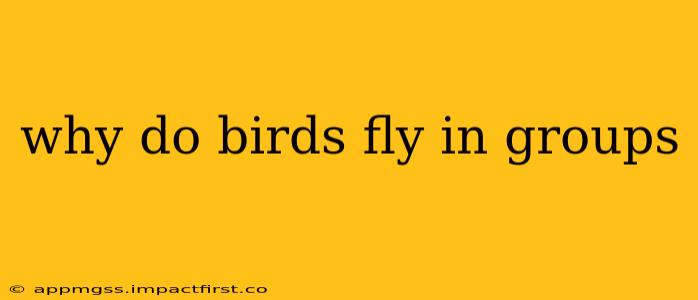Birds flying in groups, also known as flocking, is a fascinating natural phenomenon observed across numerous avian species. While the sight of a vast flock of birds can be awe-inspiring, the reasons behind this behavior are rooted in survival and efficiency. This comprehensive guide delves into the various advantages of flocking, answering common questions and exploring the intricacies of this complex avian strategy.
What are the advantages of birds flying in a flock?
The primary benefit of flocking lies in increased safety and security. Predators find it significantly more challenging to target a single bird within a large, dynamic group. The sheer number of birds makes it difficult for a predator to isolate a prey item, and the constant movement and shifting positions within the flock further confuse potential attackers. This "safety in numbers" approach is a fundamental principle in many animal societies.
Why do birds fly in formation?
While safety is key, the formation of flocks often goes beyond simply being together. Many species, like geese, fly in a specific V-formation. This formation offers several aerodynamic advantages:
- Reduced Energy Expenditure: Birds flying in formation take advantage of the updraft created by the wings of the bird in front, reducing air resistance and saving energy. This is particularly crucial during long migrations.
- Improved Navigation: Birds within a flock can learn from each other's navigational skills, improving the overall efficiency and accuracy of their journey. Experienced birds often lead the flock, guiding the younger or less experienced members.
How do birds stay together in a flock?
The coordination within a flock is truly remarkable. Birds utilize a sophisticated communication system involving:
- Visual Cues: Birds closely monitor the movements of their neighbors, adjusting their flight path accordingly.
- Auditory Signals: Calls and other vocalizations help maintain flock cohesion, especially in conditions with limited visibility.
This complex interplay of visual and auditory cues ensures that the flock remains cohesive and responds effectively to changes in the environment.
Do all birds fly in flocks?
No, not all birds fly in flocks. Many bird species are solitary or live in pairs, while others form smaller family groups. The tendency to flock varies widely depending on the species, their social structures, and their specific needs.
What are some examples of birds that flock?
Many bird species are known for their spectacular flocking behavior. Some prominent examples include:
- Starlings: Famous for their massive, mesmerizing murmurations.
- Geese: Known for their precise V-formations during migration.
- Pigeons: Often seen in large groups foraging for food.
- Quail: Typically form coveys for protection.
These examples showcase the diversity of flocking behavior across various avian species.
Why do birds fly in groups at night?
Nocturnal flocking offers similar benefits to daytime flocking: increased safety from nocturnal predators, shared warmth in cold temperatures, and improved navigational efficiency. The sheer number within the flock can also enhance predator detection, as a single bird's alarm call can trigger a rapid response from the entire group.
Are there disadvantages to flocking?
While flocking offers significant advantages, there are some potential drawbacks. Increased competition for food and nesting sites within a large group can be a challenge. Furthermore, the concentration of birds in one area makes the flock more visible to predators, although the dynamic nature of the flock often mitigates this risk.
This exploration delves into the multifaceted reasons why birds engage in flocking behavior. From enhancing safety and navigation to optimizing energy expenditure, the benefits are clear. The intricate coordination and communication within flocks highlight the remarkable intelligence and adaptability of avian species. Further research into this complex phenomenon continues to uncover more fascinating insights into the world of birds.
